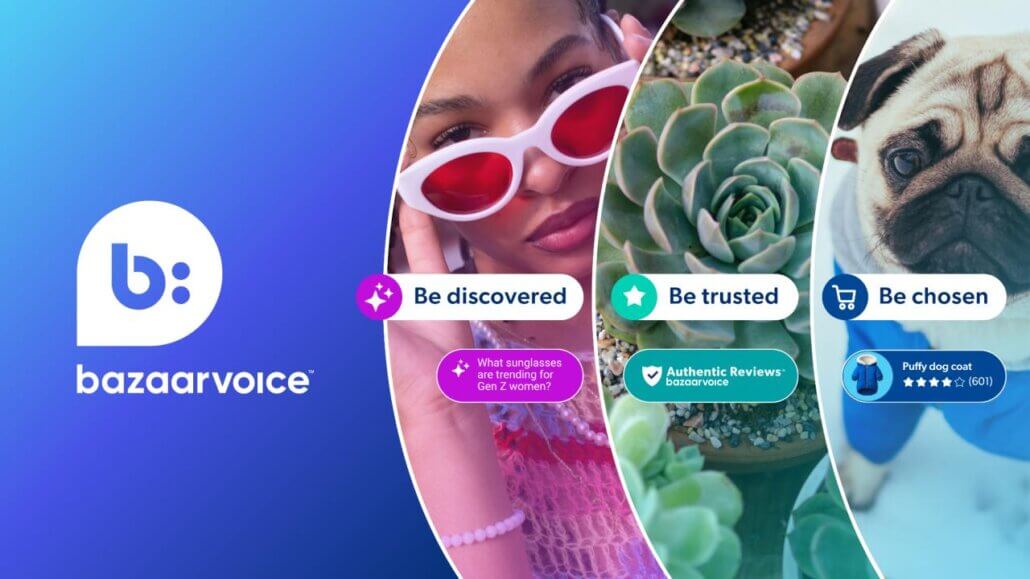April 17, 2025
The product detail page (PDP) has evolved from a static product listing into a content-rich shopping experience that drives engagement, conversion, and brand loyalty. Leading brands like SheaMoisture, Goldfish, O-Cedar, and Truvia across high-performing categories are redefining PDP strategies to capture shopper attention, integrate user-generated content (UGC), and align with retail media investments.
Why PDPs are evolving from transactional to inspirational
Shoppers expect PDPs to multitask beyond delivering basic product descriptions. They want engaging, immersive content experiences similar to what they see on social media. Research shows that featuring real people in content increases effectiveness by 81%, seamless brand integration boosts impact by 46%, and dynamic visuals drive a 74% higher performance.
Brands like O-Cedar and Truvia are responding to this shift by transforming product detail pages into storytelling-driven experiences, using authentic UGC and social-style content to create a more engaging, trust-building shopping experience.
O-Cedar emphasizes use-cases and aspirational content for actually using the product in different spaces. And Truvia has cracked the ultimate recipe for inspiration with video content, showcasing how you can create joyful experiences like baking Christmas cookies with their offerings at the center.
See how ghd launched its flagship product by leveraging authentic UGC, including inspirational video content.
The retail media & PDP connection: A full-funnel approach
That PDPs drive organic shopper engagement is table stakes. But they also play a critical role in retail media success. Strong product detail pages improve search rankings, ad performance, and conversions. Goldfish demonstrates this by aligning its product detail page content with retail media investments, ensuring a seamless transition from ad exposure to purchase. B
rands that optimize their product detail pages with rich content, reviews, and UGC see higher visibility in search results and stronger ROI on paid media. Goldfish is a prime example of how a strong PDP strategy can amplify retail media ROI by creating engaging, content-rich product pages that reinforce advertising efforts.
Optimizing the product detail page for engagement & conversion
Target’s content scorecard prioritizes imagery (photos and videos from creators, influencers) and UGC (star ratings, text reviews, Q&A), highlighting the importance of visual and social proof in driving conversions. PDP engagement now mirrors social media behavior, with shoppers expecting scrollable, video-rich content that keeps them engaged—similar to TikTok and Pinterest.
Beauty brands like SheaMoisture have the opportunity to take an omnichannel approach, ensuring that product detail pages align with brand sites, social platforms, and retail listings for a cohesive, cross-platform experience. Brands that embrace rich media and interactive product detail page elements are successfully capturing shopper attention and boosting sales.
Beauty brands aren’t the only ones who benefit from quality product detail page content! Isabella Oliver and Baukjen drove 120%+ conversion rate increase, 10%+ Average Order Value increase, and 3x higher time on site through inspirational content using Bazaarvoice Galleries.
Treat PDPs as brand-building hubs, not just product listings
Winning brands treat product detail pages as media assets. The most effective PDP strategies combine authentic UGC, high-quality visuals, and strategic content placement to create an experience that builds trust and drives conversions. Product detail pages don’t just impact organic search rankings—they also enhance paid retail media performance, making them a crucial part of the full-funnel shopping journey.
Actionable steps for brands
- Audit your product detail pages to meet your content scorecard requirements (with an emphasis on visual content).
- Align the product detail page content with retail media investments to create a cohesive full-funnel strategy.
- Leverage UGC and creator-driven content to build shopper trust and influence purchase decisions.
Now is the time for brands on Target.com to rethink their PDP strategies and turn them into powerful brand-building assets with inspirational creator content.
Start optimizing your Target PDPs
Q&A: Optimizing PDP Content for Inspiration, Trust, and Conversion
The product detail page (PDP) has evolved into a rich storytelling environment where multiple content types—images, video, UGC, and reviews—all compete for a shopper’s attention. In this Q&A following one of our virtual Retail Talks with Target, we dive into how brands can strategically harness this content to drive both inspiration and performance throughout the shopper journey.
Q: With so many content types competing for attention on a PDP—images, video, UGC, ratings & reviews—how do we determine the right mix to maximize both inspiration and conversion?
A: The key is understanding how each content type supports different stages of the funnel. At the top of the funnel, creator content is a powerful tool for building excitement and introducing products in a way that feels engaging and human.
As shoppers move into the consideration stage, creators can reinforce trust by providing educational content like tutorials, how-to videos, and product demonstrations. Closer to the point of purchase, integrating user-generated content and creator content directly on the product detail page helps boost purchase confidence and reduce friction, ultimately driving conversions.
Q: We know that creator and UGC content can build trust and engagement, but how can brands ensure the content remains brand-safe while still feeling authentic?
A: Creator content is particularly effective in paid media because it resonates with consumers more than traditional advertisements. To maintain authenticity without compromising brand safety, brands should brief creators the same way they would an agency—clearly outlining expectations, messaging, and brand guidelines.
Being intentional about placement is also essential. Whether the content is going on social, product detail pges, or sponsored listings, alignment with the intended context ensures that the content feels both genuine and on-brand. This thoughtful approach allows brands to strike a balance between authenticity and control.
Q: As PDPs evolve into richer storytelling hubs, how do we measure the impact of inspirational content beyond just direct conversion?
A: Inspirational content has a ripple effect that goes beyond a last-click conversion. To understand its impact, brands should track deeper engagement metrics such as time spent on product detail pages, add-to-cart rates, and conversion lift across channels where content is featured.
These indicators provide insight into how content contributes to the overall buyer journey, revealing its influence on shopper behavior even if it doesn’t lead to an immediate sale. Ultimately, measuring success across a range of metrics helps tell a more complete story of performance.
Q: What’s the best approach to keeping creator content on product detail pages fresh and relevant?
A: Brands should build a flexible content library that allows assets to be easily repurposed and adapted across multiple formats and placements. Regularly refreshing creator content ensures it stays timely, resonates with current trends or seasonal campaigns, and avoids becoming stale.
Having a rotation strategy in place helps maintain engagement and relevance, encouraging repeat visits and increasing the likelihood of conversion over time.
Q: How can brands encourage consumers to generate UGC?
A: Brands can prompt reviews and media uploads through post-purchase email campaigns, run sweepstakes that incentivize participation, or engage their communities on social media with calls-to-action and branded hashtags.
These efforts not only drive content creation but also deepen customer loyalty and advocacy, turning everyday shoppers into valuable contributors to the brand experience.
The Hey, Bullseye sampling community is also an effective way to reach consumers that shop directly at Target. You can leverage the community to generate a perfect mix of content that can support your overall Target scorecard.
Q: Do you have any recommendations on how to make the PDP “recession-proof” or drive convenience and value beyond listing product attributes?
A: Building a recession-proof PDP starts with increasing the quantity and quality of content. Statistics show that more content leads to better performance—just one review can lift sales by up to 10%, while 50 reviews can increase sales by 30%.
For example, when Rimmel partnered with Bazaarvoice’s Influenster community on a sampling campaign, they generated over 1,200 reviews and 15.7 million impressions across 2,400 social posts. The results were more than just engagement; the campaign drove a 44% higher sales lift compared to the IRI benchmark for beauty category digital campaigns.
By investing in UGC and authentic social proof, brands can deliver convenience, value, and trust—all of which are essential in uncertain economic times.





